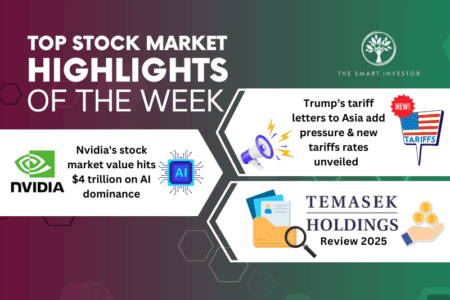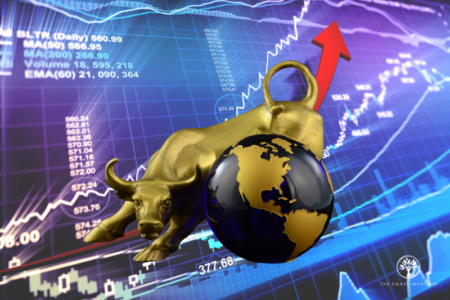The US stock market is soaring to new heights.
But what does that mean for your stock returns in 2025?
I would like to give you a definite answer but if I did so, I’d be lying to you. In fact, you should view anyone who provides you with target prices with suspicion.
Here’s the hard truth: no one can control where the market is headed in the short term.
Yet, the allure of target prices persists.
The psychology of target prices
It’s not hard to understand why target prices are popular.
The appeal lies in having an exact number to help you decide when to buy or sell shares.
But what sounds good in theory does not hold up in practice.
In early March 2020, a prominent US bank issued a rare “sell” call for Singapore banks.
The research team also cut the target price for DBS Group (SGX: D05), Singapore’s largest bank, to S$17.50.
Interestingly, just three months later, the same team made a dramatic U-turn, raising the target price to S$25.50, a significant 46% increase.
Curious, isn’t it?
What on earth could have caused this change of heart?
It boils down to the underlying assumptions.
At its core, a target price is the result of a mathematical formula. Analysts input their assumptions into the formula to arrive at a share price estimate. Naturally, if you change the inputs, the output will change as well.
Here’s where the process gets dicey.
A formula itself has no emotions. But the humans doing the calculations do. Thus, it is possible to input optimistic or pessimistic assumptions into the formula, and the target price will simply reflect a positive or negative outlook.
In effect, you’re inputting your emotions into the formula.
While these calculations are mathematically precise, there is no guarantee they will be correct.
Price is what you pay, value is what you can’t see
In the early 1980s, McKinsey, a renowned consulting firm, projected global total cell phone sales to reach about 900,000 units by 2000. Little did they know that the turn of the century would witness a staggering 405 million units sold worldwide.
How could a prestigious firm get its projection so wrong?
The answer lies in the inherent difficulty in predicting the future of rapidly evolving technologies.
The best example is Amazon.com (NASDAQ: AMZN).
In mid-2010, when I first invested in the company, it had just reported US$24.5 billion in annual revenue, primarily from its online retail business.
Here’s the twist: it was impossible to know what the business would look like a decade later.
Five years after my initial investment, in early 2015, Amazon finally disclosed the financial numbers for its cloud computing division, Amazon Web Services (AWS). At that point, AWS was already generating US$4.6 billion in annual sales and US$660 million in operating income.
Fast forward to 2023, and AWS had become a financial cash cow with nearly US$90 billion in annual revenue and an impressive US$24.6 billion in operating income.
In other words, AWS, an insignificant division back in 2009, had generated more operating income in 2023 than the entire company’s revenue in 2009.
That’s just the first positive surprise.
In early 2017, Amazon lifted the veil on its subscription business, revealing annual sales of US$6.4 billion.
By 2023, annual segment sales had ballooned to an impressive US$40.2 billion.
Then, in early 2022, the online retailer revealed that it was generating over US$31 billion in annual advertising revenue.
By 2023, annual segment sales came in at US$47 billion.
For those who have been keeping count, that’s three new businesses which barely registered a blip in 2009 but yet had collectively generated US$178 billion in revenue for 2023, well over seven times its 2009 revenue.
In my view, it is unlikely that anyone would have predicted the size of any of these three businesses today, let alone all three.
It’s better to be roughly right than precisely wrong
Then again, if investors cannot accurately predict the future, does this mean they should abandon valuing stocks altogether?
Not so fast.
Howard Marks, the co-chairman of Oaktree Capital Management, once shared an intriguing thought: “We never know where we’re going, but we ought to know where we are.”
If we may be so bold as to apply his way of thinking to valuing stocks, it paves the way for the practical application of stock valuation.
In my view, comparing the stock’s current valuation (say, its price-to-earnings ratio) against its historical trading range provides us with a clue on whether shares are expensive or cheap.
That’s not all.
There could be good reasons why a stock is trading higher or lower compared to its historical trading range. For instance, if a business is facing key challenges, it could explain why the stock is trading at a relatively lower valuation.
The key here is not to get hung up over the precision of your valuation.
As investors, the best you can do is to tilt the odds in your favour. Ideally, if you can find a business which is still doing well and trading at a decent valuation, you stand a better chance of coming out ahead a decade down the road.
Get Smart: It’s about managing risk, not target prices
When it comes to investing, there are many roads to Rome.
To be fair, there are investors who have done well by focusing solely on stock valuation.
For me, however, I like to go back to the reason why valuation is used in the first place: to reduce your investment risk. The way I see it, valuation is one of the many ways you can employ to manage risk.
Be warned: valuation is not the only risk in investing.
A weak, shrinking business can pose risks that no amount of stock valuation can solve.
Hence, starting with high-quality businesses is my preferred approach. Beyond that, you can consider sizing your stock position and spacing out your additional buys according to the business’s risk level.
If a business is unproven, consider sizing your initial stock position smaller, and be generous in giving time for the business to prove itself.
Never fear that you may be missing out if you don’t act immediately.
After all, if a stock is destined to be as successful as Amazon, you’ll have plenty of time to add to it in the future.
Note: An earlier version of this article appeared in The Business Times.
Want to protect your child’s money from inflation? Transform your child’s ‘piggy bank’ into a ‘golden goose’ that keeps giving even until they have grandchildren. Our latest FREE report shows you a stress-free method and 3 superstar stocks that could protect your child’s money from inflation. Click HERE to get a copy of our latest guide.
Disclosure: Chin Hui Leong owns shares of Amazon and DBS Group.





